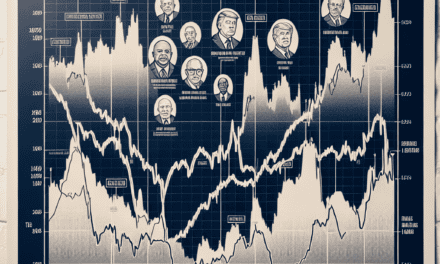“Market Surge: Trump Trades Ignite a Bullish Wave in Stocks and Yields!”
Introduction
In recent financial markets, a notable phenomenon has emerged, dubbed the “Market Surge,” characterized by a significant uptick in both stock prices and bond yields. This surge has been largely attributed to trading activities and economic policies associated with former President Donald Trump. Investors and analysts have observed that Trump’s influence, whether through direct policy announcements or broader economic strategies, has played a pivotal role in shaping market dynamics. The resulting market movements have sparked discussions about the sustainability of such trends and the potential long-term impacts on the global financial landscape. As traders and policymakers navigate this complex environment, the interplay between political developments and market responses continues to be a focal point of analysis and debate.
Impact Of Trump Trades On Stock Market Dynamics
The recent surge in the stock market, driven by what has been termed “Trump trades,” has captured the attention of investors and analysts alike. This phenomenon, characterized by a significant uptick in stock prices and bond yields, can be attributed to a series of economic policies and statements associated with former President Donald Trump. As market participants react to these developments, it is crucial to understand the underlying dynamics and potential implications for the broader financial landscape.
To begin with, the concept of “Trump trades” refers to the market’s response to policies and rhetoric that emphasize deregulation, tax cuts, and infrastructure spending. These elements, which were central to Trump’s economic agenda, have historically been perceived as catalysts for economic growth. Consequently, investors have often reacted positively to any indication that such policies might be implemented or reinforced. This optimism is reflected in the rising stock prices, as market participants anticipate increased corporate profits and economic expansion.
Moreover, the impact of Trump trades extends beyond equities, influencing bond markets as well. The expectation of robust economic growth often leads to concerns about inflationary pressures, prompting investors to demand higher yields on government bonds. As a result, bond yields have risen in tandem with stock prices, reflecting a complex interplay between growth expectations and inflation fears. This dynamic underscores the interconnectedness of financial markets, where shifts in one asset class can reverberate across others.
In addition to these economic factors, the psychological aspect of market behavior cannot be overlooked. Investor sentiment plays a pivotal role in shaping market trends, and the association of Trump’s policies with economic prosperity has fostered a sense of optimism among many market participants. This sentiment is further amplified by media coverage and public discourse, which often highlight the potential benefits of pro-growth policies. As a result, the market’s response to Trump trades is not solely driven by fundamental analysis but is also influenced by the collective mindset of investors.
However, it is important to recognize that the impact of Trump trades is not uniformly positive. While some sectors, such as financials and industrials, may benefit from deregulation and infrastructure spending, others could face challenges. For instance, industries reliant on international trade might be adversely affected by protectionist measures, leading to increased volatility and uncertainty. This divergence highlights the need for investors to adopt a nuanced approach, considering both the opportunities and risks associated with Trump trades.
Furthermore, the long-term sustainability of this market surge remains a topic of debate. While short-term gains are evident, questions persist regarding the potential consequences of increased fiscal spending and tax cuts on the national debt and budget deficit. These concerns could weigh on investor confidence, particularly if economic growth fails to meet expectations. Therefore, it is essential for market participants to remain vigilant and adaptable, as the landscape continues to evolve.
In conclusion, the phenomenon of Trump trades has undeniably influenced stock market dynamics, driving both stocks and yields higher. This surge is underpinned by a combination of economic policies, investor sentiment, and market psychology. As the financial landscape continues to shift, understanding the multifaceted impact of these trades is crucial for investors seeking to navigate the complexities of today’s markets. By considering both the opportunities and challenges presented by Trump trades, market participants can make informed decisions that align with their investment objectives.
Analyzing The Surge In Yields Due To Trump Trades
The recent surge in market yields, driven by what has been termed “Trump trades,” has captured the attention of investors and analysts alike. This phenomenon, characterized by a significant uptick in stock prices and bond yields, can be attributed to a confluence of factors associated with the economic policies and political maneuvers of former President Donald Trump. As we delve into the intricacies of this market movement, it is essential to understand the underlying causes and potential implications for the broader financial landscape.
To begin with, the term “Trump trades” refers to the market’s reaction to policies and expectations set during Trump’s presidency, which continue to influence investor behavior. These trades are primarily driven by the anticipation of deregulation, tax reforms, and infrastructure spending, all of which were central themes during Trump’s tenure. The promise of reduced regulatory burdens and lower corporate taxes created an environment conducive to business growth, thereby boosting investor confidence and driving stock prices higher. Consequently, this optimism has spilled over into the bond market, resulting in increased yields.
Moreover, the anticipation of substantial infrastructure spending has further fueled market enthusiasm. Investors are betting on the potential for large-scale projects to stimulate economic growth, thereby increasing demand for commodities and industrial goods. This expectation has led to a rotation into cyclical stocks, which are more sensitive to economic fluctuations, further propelling the stock market upward. As stock prices rise, bond yields have followed suit, reflecting the market’s expectation of higher inflation and interest rates in the future.
In addition to these economic policies, geopolitical factors have also played a role in shaping the market dynamics associated with Trump trades. The former president’s approach to international trade, characterized by a focus on renegotiating trade agreements and imposing tariffs, has had a lasting impact on global supply chains and market sentiment. While some industries have benefited from protective measures, others have faced increased costs and uncertainty. This complex interplay has contributed to the volatility observed in both stock and bond markets.
Furthermore, the Federal Reserve’s monetary policy stance has been a critical factor influencing yields. During Trump’s presidency, the Fed embarked on a path of gradual interest rate hikes, aiming to normalize monetary policy in response to a strengthening economy. This tightening cycle, coupled with fiscal stimulus measures, has led to higher yields as investors adjust their expectations for future interest rates. The interplay between fiscal and monetary policy continues to be a key driver of market movements, as investors assess the potential for further rate adjustments in response to evolving economic conditions.
As we consider the implications of this market surge, it is important to recognize the potential risks and opportunities that lie ahead. On one hand, the continued rise in yields could signal a robust economic recovery, providing a favorable environment for equities and risk assets. On the other hand, higher yields may pose challenges for fixed-income investors and could lead to increased borrowing costs for businesses and consumers. Additionally, the potential for inflationary pressures remains a concern, as rising prices could erode purchasing power and dampen economic growth.
In conclusion, the surge in yields attributed to Trump trades reflects a complex interplay of economic policies, geopolitical factors, and monetary policy dynamics. As investors navigate this evolving landscape, it is crucial to remain vigilant and adaptable, recognizing both the opportunities and challenges that may arise. By understanding the underlying drivers of this market movement, stakeholders can make informed decisions that align with their financial objectives and risk tolerance.
Key Sectors Benefiting From Trump-Induced Market Surge
The recent market surge, driven by trades associated with former President Donald Trump, has captured the attention of investors and analysts alike. This phenomenon has not only propelled stock prices to new heights but also influenced bond yields, creating a ripple effect across various sectors. As we delve into the key sectors benefiting from this Trump-induced market surge, it is essential to understand the underlying factors contributing to this financial upswing.
To begin with, the technology sector has emerged as a significant beneficiary of the current market dynamics. With Trump’s continued influence on economic policies and his vocal support for deregulation, tech companies have experienced a boost in investor confidence. This confidence is further bolstered by the sector’s inherent resilience and adaptability, which have been crucial in navigating the challenges posed by the global pandemic. As a result, tech stocks have seen substantial gains, with major players like Apple, Microsoft, and Amazon leading the charge.
In addition to technology, the energy sector has also reaped the rewards of the Trump trades. The former president’s policies have historically favored fossil fuel industries, and his ongoing advocacy for energy independence has resonated with investors. Consequently, oil and gas companies have witnessed a surge in stock prices, driven by expectations of increased production and reduced regulatory constraints. This optimism is further amplified by the global economic recovery, which has spurred demand for energy resources, thereby enhancing the sector’s profitability.
Moreover, the financial sector has not been left behind in this market rally. Trump’s influence on fiscal policies, particularly his stance on tax cuts and deregulation, has created a favorable environment for banks and financial institutions. These entities have benefited from rising interest rates, which have improved their net interest margins and overall profitability. Additionally, the anticipation of further economic growth has led to increased lending activity, providing a further boost to the sector’s performance.
Transitioning to the industrial sector, it is evident that Trump’s emphasis on infrastructure development and domestic manufacturing has played a pivotal role in its recent success. The promise of increased government spending on infrastructure projects has fueled investor optimism, leading to a surge in stock prices for construction and engineering firms. Furthermore, the push for reshoring manufacturing operations has bolstered the prospects of companies involved in the production of goods domestically, thereby enhancing their market position.
The healthcare sector, while traditionally more insulated from political influences, has also experienced positive momentum. Trump’s focus on reducing drug prices and increasing transparency in healthcare costs has created opportunities for companies that can adapt to these changes. Pharmaceutical and biotechnology firms, in particular, have benefited from increased investment in research and development, as well as the accelerated approval processes for new treatments and vaccines.
In conclusion, the Trump-induced market surge has had a profound impact on various sectors, each benefiting from specific policy influences and economic trends. The technology, energy, financial, industrial, and healthcare sectors have all experienced significant gains, driven by a combination of investor confidence, favorable policy environments, and broader economic recovery. As these sectors continue to navigate the evolving market landscape, it remains to be seen how sustainable this growth will be in the long term. Nonetheless, the current market dynamics underscore the intricate interplay between political influence and financial markets, highlighting the importance of strategic investment decisions in an ever-changing economic environment.
Investor Sentiment: How Trump Trades Influence Market Behavior

Investor sentiment plays a crucial role in shaping market behavior, and recent developments have underscored the significant impact of what are colloquially known as “Trump trades.” These trades, influenced by the policies and rhetoric of former President Donald Trump, have once again propelled stocks and yields higher, reflecting a complex interplay of economic optimism and geopolitical considerations. Understanding the dynamics behind this surge requires a closer examination of the factors driving investor confidence and the broader implications for financial markets.
To begin with, the resurgence of Trump trades can be attributed to a renewed focus on economic policies reminiscent of the Trump administration. Investors are particularly attuned to potential tax cuts, deregulation, and infrastructure spending, which were hallmark strategies during Trump’s tenure. These policies are perceived as catalysts for economic growth, prompting investors to recalibrate their portfolios in anticipation of favorable market conditions. Consequently, sectors such as energy, financials, and industrials have experienced notable gains, as they stand to benefit directly from such policy shifts.
Moreover, the influence of Trump trades extends beyond domestic policies to encompass international relations. The former president’s approach to trade negotiations and foreign policy, characterized by a blend of assertiveness and unpredictability, has left a lasting imprint on market sentiment. Investors are keenly aware of the potential for renewed trade tensions or diplomatic maneuvers that could impact global supply chains and economic stability. As a result, market participants are closely monitoring geopolitical developments, adjusting their strategies to mitigate risks and capitalize on opportunities.
In addition to policy considerations, the psychological aspect of investor behavior cannot be overlooked. The Trump brand, synonymous with bold decision-making and market disruption, continues to evoke strong reactions among investors. This emotional response can amplify market movements, as traders react swiftly to news or statements associated with Trump. The resulting volatility, while challenging for some, presents lucrative opportunities for others, particularly those adept at navigating short-term fluctuations.
Furthermore, the current economic landscape provides fertile ground for the resurgence of Trump trades. With inflationary pressures persisting and central banks grappling with interest rate decisions, investors are seeking assets that offer protection against rising prices and potential monetary tightening. In this context, equities and commodities linked to Trump-era policies are perceived as attractive hedges, driving demand and pushing prices higher. Simultaneously, bond yields have risen as investors anticipate stronger economic growth and the possibility of more aggressive rate hikes.
As we consider the broader implications of this market surge, it is essential to recognize the potential for both opportunities and challenges. On one hand, the renewed focus on growth-oriented policies could stimulate economic activity, boost corporate earnings, and enhance investor returns. On the other hand, the inherent volatility and uncertainty associated with Trump trades necessitate a cautious approach. Investors must remain vigilant, balancing their pursuit of gains with prudent risk management strategies.
In conclusion, the influence of Trump trades on market behavior underscores the intricate relationship between investor sentiment and economic policy. As stocks and yields continue to rise, driven by expectations of favorable policy shifts and geopolitical developments, market participants must navigate a landscape characterized by both promise and unpredictability. By understanding the underlying dynamics and maintaining a disciplined approach, investors can position themselves to capitalize on the opportunities presented by this latest market surge.
Comparing Historical Market Surges With The Trump Trade Phenomenon
The financial markets have always been a reflection of economic sentiment, political developments, and investor confidence. Throughout history, there have been numerous instances where markets have experienced significant surges, driven by a variety of factors. One such phenomenon that has captured the attention of investors and analysts alike is the so-called “Trump Trade,” which refers to the market movements following the election of Donald Trump as the President of the United States in 2016. To understand the uniqueness of this event, it is essential to compare it with historical market surges and examine the underlying causes and implications.
Historically, market surges have often been triggered by major geopolitical events, technological advancements, or shifts in economic policy. For instance, the post-World War II economic boom was characterized by rapid industrial growth and technological innovation, leading to a sustained period of market expansion. Similarly, the dot-com bubble of the late 1990s was driven by the proliferation of internet-based companies and the widespread adoption of digital technologies. In both cases, the market surges were underpinned by tangible changes in the economic landscape, which fueled investor optimism and drove stock prices higher.
In contrast, the Trump Trade phenomenon was primarily driven by expectations rather than immediate economic changes. Following Trump’s election, markets surged on the anticipation of pro-business policies, including tax cuts, deregulation, and infrastructure spending. Investors speculated that these measures would stimulate economic growth, boost corporate profits, and lead to higher stock valuations. Consequently, both stocks and bond yields experienced a significant uptick, reflecting the market’s optimistic outlook.
While the Trump Trade shares some similarities with past market surges, such as the role of investor sentiment and the anticipation of policy changes, it also differs in several key aspects. One notable difference is the speed and intensity of the market reaction. The post-election rally was swift and pronounced, with major indices reaching record highs within weeks. This rapid response can be attributed to the heightened role of algorithmic trading and the increased interconnectedness of global financial markets, which amplify market movements and accelerate the dissemination of information.
Moreover, the Trump Trade was characterized by a divergence in market performance across different sectors. While financials and industrials benefited from the prospect of deregulation and infrastructure spending, other sectors, such as technology and healthcare, faced uncertainty due to potential policy shifts. This sectoral disparity highlights the complexity of the Trump Trade and underscores the importance of understanding the nuanced impacts of political developments on market dynamics.
In comparing the Trump Trade with historical market surges, it is evident that while the underlying drivers may differ, the fundamental principles of market behavior remain consistent. Investor sentiment, policy expectations, and economic outlook continue to play pivotal roles in shaping market trends. However, the Trump Trade also serves as a reminder of the evolving nature of financial markets, where technological advancements and global interconnectedness can amplify and accelerate market reactions.
In conclusion, the Trump Trade phenomenon offers valuable insights into the interplay between politics and markets, illustrating both the enduring principles and the evolving dynamics of market surges. By examining this event in the context of historical precedents, investors and analysts can gain a deeper understanding of the factors that drive market movements and better navigate the complexities of the modern financial landscape.
Risks And Opportunities In The Wake Of Trump Trades
In recent months, the financial markets have experienced a notable surge, driven in part by what analysts are calling “Trump trades.” This term refers to the market movements influenced by policies and statements from former President Donald Trump, which continue to impact investor sentiment and decision-making. As stocks and yields climb, it is essential to examine the risks and opportunities that accompany this market phenomenon.
The resurgence of Trump trades can be attributed to several factors, including the anticipation of policy shifts and regulatory changes that could affect various sectors. Investors are particularly focused on industries such as energy, finance, and manufacturing, which were significantly impacted during Trump’s presidency. The expectation of deregulation and tax reforms has reignited interest in these sectors, leading to increased trading activity and, consequently, higher stock prices.
However, with these opportunities come inherent risks. The volatility associated with Trump trades is a double-edged sword. On one hand, it presents the potential for substantial gains; on the other, it poses significant risks for investors who may not be prepared for sudden market shifts. The unpredictability of political developments and their impact on economic policies can lead to rapid changes in market conditions, making it crucial for investors to remain vigilant and adaptable.
Moreover, the global economic landscape adds another layer of complexity to the situation. As the world grapples with ongoing challenges such as inflation, supply chain disruptions, and geopolitical tensions, the influence of Trump trades on international markets cannot be overlooked. Investors must consider how these global factors interact with domestic policies to fully understand the potential outcomes of their investment strategies.
In light of these complexities, diversification emerges as a key strategy for mitigating risks associated with Trump trades. By spreading investments across various asset classes and sectors, investors can reduce their exposure to any single market event or policy change. This approach not only helps in managing risk but also allows investors to capitalize on opportunities that may arise in different areas of the market.
Furthermore, staying informed about political developments and their potential economic implications is crucial for navigating the current market environment. Investors should closely monitor policy announcements, legislative changes, and geopolitical events that could influence market dynamics. By maintaining a proactive approach, they can better anticipate market movements and adjust their strategies accordingly.
In addition to diversification and staying informed, investors should also consider the role of technology in shaping market trends. The rise of algorithmic trading and artificial intelligence has transformed the way markets operate, offering new tools for analyzing data and making informed decisions. Leveraging these technologies can provide investors with a competitive edge, enabling them to identify patterns and trends that may not be immediately apparent through traditional analysis.
In conclusion, the market surge driven by Trump trades presents both risks and opportunities for investors. While the potential for significant gains is enticing, the associated volatility and unpredictability require careful consideration and strategic planning. By adopting a diversified approach, staying informed about political and economic developments, and leveraging technological advancements, investors can navigate the complexities of the current market landscape and position themselves for success. As the financial world continues to evolve, the ability to adapt and respond to changing conditions will be paramount in capitalizing on the opportunities that arise in the wake of Trump trades.
Future Outlook: Sustaining The Momentum Of Trump-Driven Market Gains
The recent surge in the financial markets, driven by strategic trades associated with former President Donald Trump, has captured the attention of investors and analysts alike. As stocks and yields experience a notable upswing, the focus now shifts to the sustainability of these gains and the potential implications for the broader economic landscape. Understanding the factors that have contributed to this market rally is crucial for anticipating future trends and making informed investment decisions.
To begin with, the Trump-driven market gains can be attributed to a combination of policy expectations, investor sentiment, and strategic positioning. The anticipation of potential policy shifts, particularly in areas such as taxation, deregulation, and infrastructure spending, has fueled optimism among investors. This optimism is further bolstered by the belief that such policies could stimulate economic growth, enhance corporate profitability, and ultimately drive stock prices higher. Consequently, investors have been reallocating their portfolios to capitalize on these anticipated changes, leading to increased demand for equities and a corresponding rise in stock prices.
Moreover, the impact of investor sentiment cannot be understated. The market’s reaction to Trump’s influence is not solely based on concrete policy actions but also on the perception of his ability to effect change. This perception has created a sense of confidence among investors, encouraging them to take on more risk and invest in assets that are expected to benefit from a Trump-led economic agenda. As a result, the market has experienced a surge in trading volumes and heightened volatility, reflecting the dynamic nature of investor expectations.
In addition to these factors, the role of strategic positioning by institutional investors has played a significant part in driving market gains. Large investment firms, hedge funds, and other institutional players have been actively adjusting their portfolios to align with the anticipated policy landscape. This strategic repositioning has led to increased buying pressure in certain sectors, such as financials, industrials, and energy, which are perceived to be beneficiaries of Trump’s policies. The resulting inflow of capital into these sectors has contributed to the overall upward momentum in the market.
However, sustaining the momentum of Trump-driven market gains requires careful consideration of several key factors. Firstly, the actual implementation of proposed policies will be critical in determining the long-term impact on the economy and financial markets. Investors will be closely monitoring legislative developments and the ability of policymakers to translate rhetoric into actionable measures. Any delays or deviations from expected policy outcomes could dampen investor enthusiasm and lead to market corrections.
Furthermore, external economic conditions and geopolitical developments will also play a crucial role in shaping the future trajectory of the market. Global economic trends, trade relations, and geopolitical tensions can all influence investor sentiment and market dynamics. As such, maintaining a balanced perspective and being attuned to these external factors will be essential for navigating the complexities of the market environment.
In conclusion, while the recent market surge driven by Trump trades has generated significant gains, the sustainability of this momentum hinges on a multitude of factors. The interplay between policy expectations, investor sentiment, and strategic positioning will continue to shape market dynamics in the coming months. By staying informed and adaptable, investors can better position themselves to capitalize on opportunities and mitigate risks in this evolving landscape. As the market continues to respond to the unfolding economic and political developments, maintaining a vigilant and proactive approach will be key to sustaining the momentum of Trump-driven market gains.
Q&A
1. **What is Market Surge?**
Market Surge refers to a significant increase in stock prices and bond yields, often driven by specific economic or political events.
2. **What caused the recent Market Surge?**
The recent Market Surge was propelled by trades and policies associated with former President Donald Trump, which influenced investor sentiment and market dynamics.
3. **How did Trump Trades impact stocks?**
Trump Trades led to increased investor confidence, resulting in higher stock prices as investors anticipated favorable economic conditions and policies.
4. **What sectors benefited the most from the Market Surge?**
Sectors such as finance, energy, and manufacturing often benefit from policies associated with Trump Trades, leading to notable gains during the Market Surge.
5. **How did bond yields react to the Market Surge?**
Bond yields increased as investors shifted their focus to equities, anticipating higher economic growth and inflation, which typically lead to higher interest rates.
6. **What are the potential risks of a Market Surge driven by Trump Trades?**
Potential risks include market volatility, policy reversals, and geopolitical tensions that could undermine investor confidence and lead to market corrections.
7. **What should investors consider during a Market Surge?**
Investors should consider diversifying their portfolios, assessing risk tolerance, and staying informed about policy changes and economic indicators that could impact market conditions.
Conclusion
The recent market surge, driven by trades associated with former President Donald Trump, has led to a notable increase in both stock prices and bond yields. This phenomenon reflects investor optimism and heightened market activity, likely influenced by Trump’s economic policies or political developments. However, while the immediate impact appears positive, it is essential to consider the potential for increased volatility and the underlying economic fundamentals that may affect long-term market stability. Investors should remain cautious and informed, balancing short-term gains with strategic risk management.




